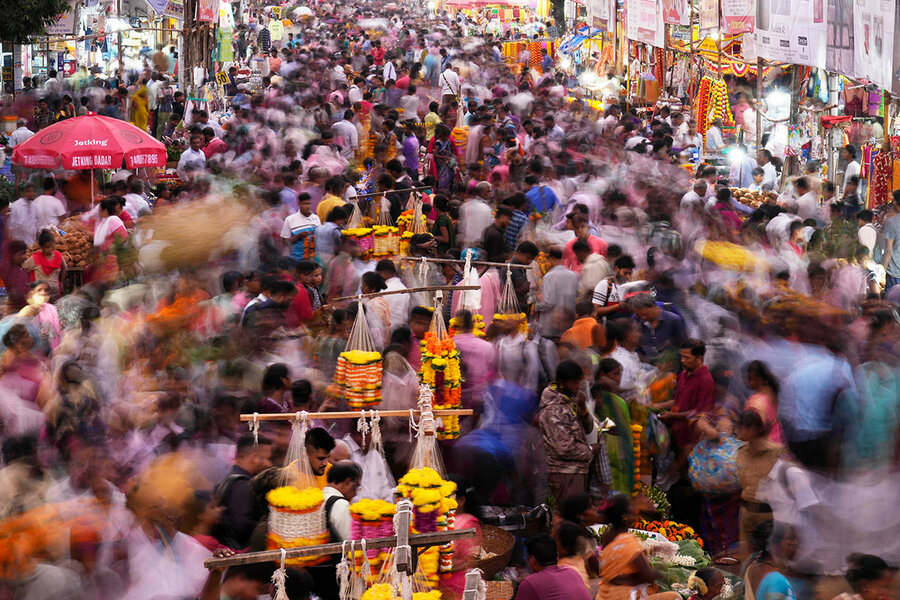India tops population table. Will the economy follow?
Loading...
| London
It is the world’s most populous nation. An Asian power with ancient roots, a rapidly modernizing economy, nuclear weapons, and a large military budget, it is intent on claiming what it sees as its rightful, top-table place in world affairs.
And it is not China.
Why We Wrote This
A story focused onBecoming the most populous nation in the world gives India new geopolitical clout and economic potential. Has the country’s time really come?
It is India, which this week officially overtakes its giant neighbor’s population with a total of over 1.425 billion people.
Prime Minister Narendra Modi, seeking to navigate his country’s way between China and the United States, faces another, perhaps more daunting challenge: to narrow the still-yawning economic gap between his nation and the two competing superpowers.
India has made remarkable economic progress in recent decades; poverty levels have fallen, educational levels have risen, and the country is attracting more foreign investment as international companies think twice about China.
But it still cannot provide enough jobs to employ its rising population. Mr. Modi seems to be counting on boosting investment, and despite doubts about his democratic credentials, Western governments seem ready to set their concerns aside.
After all, India is not China. And an economically successful, internationally assertive India could provide an important counterweight to China, in Asia and beyond.
It is the world’s most populous nation. An Asian power with ancient roots, a rapidly modernizing economy, nuclear weapons, and a large military budget, it is intent on claiming what it sees as its rightful, top-table place in world affairs.
And it is not China.
It is India, which this week officially overtakes its giant neighbor’s population with a total of over 1.425 billion people. That milestone comes a few months after India displaced Britain as the world’s fifth-largest economy. These are nicely timed fillips as Delhi prepares to host the G-20 summit this autumn.
Why We Wrote This
A story focused onBecoming the most populous nation in the world gives India new geopolitical clout and economic potential. Has the country’s time really come?
Yet alongside huge promise, India faces huge challenges, at home and abroad.
And how its Hindu-nationalist prime minister, Narendra Modi, navigates these challenges – as China and America root for quite different outcomes – will have implications beyond India. They could impact relations between Washington and Beijing, and the shape of 21st-century world politics.
Mr. Modi’s geopolitical challenge is delicate enough: staking out a role for a rising India between the superpower rivals. Yet setting a path to sustained economic growth – and narrowing a still-yawning gap with China and the United States – could prove even more daunting.
“India’s time has come,” Mr. Modi says. And, in some ways, he has good reason to feel upbeat.
The economy has been booming. It is unrecognizable from a few decades ago, when I traveled around India as a college student and lived in one of its hundreds of thousands of farming villages while researching a development economics project.
With education levels rising, poverty rates falling, a technology and services sector thriving, and billions of dollars pouring into long-overdue infrastructure, India’s economy is on course to grow at a world-leading clip of nearly 6% this year, according to the International Monetary Fund.
In another area critical to growth, Western investment, China’s loss may prove India’s gain. The combination of pandemic dislocations and U.S. restrictions on high-tech trade has dampened some companies’ enthusiasm for new projects in China.
Even companies likely to stay there are viewing India as a way to hedge that commitment. This month, Apple’s CEO, Tim Cook, opened the company’s first retail stores in India. While the long-term attraction is a huge potential consumer market, Apple is already shifting some iPhone production to India: a quarter of the handsets could be produced there within the next few years.
On the world stage, too, Mr. Modi has reason to feel bullish. Both China and America have been keen to make nice with India and play down areas of friction, as their own ties get ever chillier.
Still, to be able truly to declare “India’s time has come,” he will need to tackle a range of thorny economic, social, and political challenges.
The economic strides have been enormous. So, too, gains in education and infrastructure.
But many of the problems facing India when I lived and researched there in the 1970s persist.
Literacy levels have risen; in those days fewer than half of Indians could read. But the national figure still hovers around 80%, and it’s just 65% for girls. Rural schools especially are struggling from a shortage of qualified teachers and, often, a lack of running water and basic sanitation.
Hundreds of millions of Indians have been lifted out of poverty. But the rural poverty line is only 40 cents a day, and more than 200 million Indians still fall below it. India’s annual per capita GDP is around $2,000.
And while the population picture ought to be good news for its economy – disproportionately young and still growing – many of the millions who join the employment market each year are finding it hard, even impossible, to get a well-paying job.
Indeed, many seem to have stopped trying. Less than half of working-age Indians have a job or are looking for one, according to a 2021 World Bank report. Only about one-fifth of Indian women are working.
Mr. Modi’s hope seems to rest on attracting large-scale investment, encouraged by success in the south of India, where IT-support businesses, call centers, and other service industries have become world-leading partners for major Western companies.
The lure of India’s vast market may prove less enticing, at least in the short term. Even an expanding and increasingly prosperous middle class lacks the purchasing power to snap up the latest iPhones.
It is in Mr. Modi’s drive to remedy this situation that his economic strategy and his geopolitical balancing act may intersect.
India is not about to break with China, its No. 1 trading partner and a fellow member of the BRICS economic grouping, alongside Russia, Brazil, and South Africa.
But Mr. Modi does see China as a regional rival, and shares the growing concern in Washington and allied Asian capitals over China’s expanding military and economic ambitions.
India has points of friction with the U.S. too. Mr. Modi has sat on the fence over Russia’s invasion of Ukraine, for example, and he has presided over a steady erosion of civil liberties and press freedom in a country he frequently extols as the world’s largest democracy.
But the main reason why India’s time may have come lies in a simple fact that seems to outweigh Washington’s differences with Mr. Modi.
It is that India is not China.
And that an economically successful, internationally assertive India could provide an important counterweight to China, in Asia and beyond.










